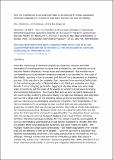Files in this item
How the importance of survival estimates in estimating Whinchat population dynamics depends on the scale of migratory connectivity and site fidelity
Item metadata
| dc.contributor.author | Cresswell, Will | |
| dc.contributor.editor | Bastian, Hans-Valentin | |
| dc.contributor.editor | Feulner, Jurgen | |
| dc.date.accessioned | 2015-07-06T08:40:02Z | |
| dc.date.available | 2015-07-06T08:40:02Z | |
| dc.date.issued | 2015 | |
| dc.identifier | 192074404 | |
| dc.identifier | 6740d49e-3b79-428d-8203-1be89f3dd8a7 | |
| dc.identifier.citation | Cresswell , W 2015 , How the importance of survival estimates in estimating Whinchat population dynamics depends on the scale of migratory connectivity and site fidelity . in H-V Bastian & J Feulner (eds) , Proceedings of the 1st European Whinchat Symposium : Living on the edge of extinction in Europe . Landesbund fur Vogelschutz / Kreisgruppe Hof , LBV Hof Helmsbrechts , pp. 145-158 , 1st European Whinchat Symposium , Helmbrechts , Germany , 28/05/15 . | en |
| dc.identifier.citation | other | en |
| dc.identifier.isbn | 9783000495052 | |
| dc.identifier.other | ORCID: /0000-0002-4684-7624/work/60426917 | |
| dc.identifier.uri | https://hdl.handle.net/10023/6908 | |
| dc.description.abstract | Accurate monitoring of whinchat population dynamics requires accurate estimates of breeding season survival and productivity, non-breeding survival and site fidelity (dispersal, immigration and emmigration). But monitoring of non-breeding survival between breeding seasons is confounded by the scale of site fidelity resulting in low estimates, and this will vary dependent on breeding success. Only one study (in progress) has measured true survival of whinchats on the wintering grounds (in Nigeria) where site fidelity is probably very high. Results from an ongoing geolocator tagging study also show only very large scale connectivity (at the scale of thousands of kilometres) between breeding and wintering populations. This means that annual survival rates measured at any point on the wintering ground probably average true breeding and migration survival for a large part of the breeding range, giving a representative true survival rate to use in calculating population dynamics. More importantly, if we have a measure of true average annual survival then we can calculate the proportion of adults that are dispersing and also the scale at which they disperse for breeding populations. Between winter survival rates for whinchats are the same for first year birds and adults suggesting that the ubiquitous lower survival rate of juveniles must arise between fledging and arrival at their wintering territory: therefore survival estimates for this period should be investigated. If survival immediately post-fledging or just before migration is variable then this will greatly affect local population dynamics, but once migration starts – the multiple routes and large scale connectivity - will mean populations over a large area will be affected to the same degree. If survival during first migration has declined substantially anywhere then many populations in the Palearctic will be affected. Average annual true survival for whinchats greater than about 4 months old, across much of Eastern Europe is greater than 50%: therefore it is it likely that local productivity or survival pre-migration determines an individual population’s dynamics, with the overall trajectory for the population being determined by the additive effect of first migration survival. However, further estimates of whinchat true annual survival are needed from other areas of Africa to determine if overwinter survival is always high: if not then this variation would negatively affect all Palearctic whinchat populations because of large scale connectivity, in the same way that first migration survival may do. | |
| dc.format.extent | 288602 | |
| dc.language.iso | eng | |
| dc.publisher | Landesbund fur Vogelschutz / Kreisgruppe Hof | |
| dc.relation.ispartof | Proceedings of the 1st European Whinchat Symposium | en |
| dc.subject | QH301 Biology | en |
| dc.subject | SDG 10 - Reduced Inequalities | en |
| dc.subject.lcc | QH301 | en |
| dc.title | How the importance of survival estimates in estimating Whinchat population dynamics depends on the scale of migratory connectivity and site fidelity | en |
| dc.type | Conference item | en |
| dc.contributor.institution | University of St Andrews. School of Biology | en |
| dc.contributor.institution | University of St Andrews. Scottish Oceans Institute | en |
| dc.contributor.institution | University of St Andrews. Institute of Behavioural and Neural Sciences | en |
| dc.contributor.institution | University of St Andrews. St Andrews Sustainability Institute | en |
| dc.contributor.institution | University of St Andrews. Centre for Biological Diversity | en |
| dc.identifier.url | http://hof.lbv.de/braunkehlchensymposium/symposiumsband-living-on-the-edge-of-extinction.html | en |
This item appears in the following Collection(s)
Items in the St Andrews Research Repository are protected by copyright, with all rights reserved, unless otherwise indicated.

